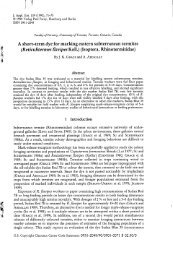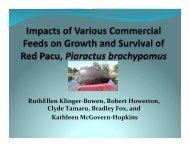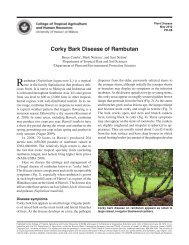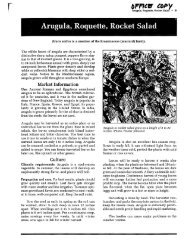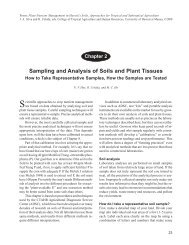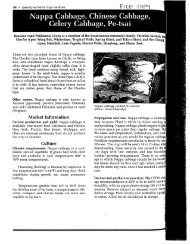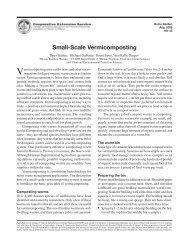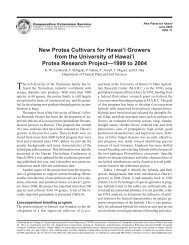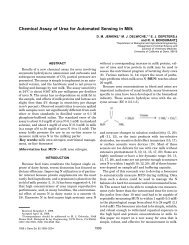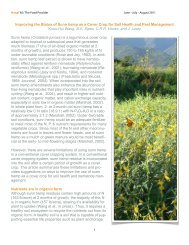Avocado - College of Tropical Agriculture and Human Resources ...
Avocado - College of Tropical Agriculture and Human Resources ...
Avocado - College of Tropical Agriculture and Human Resources ...
Create successful ePaper yourself
Turn your PDF publications into a flip-book with our unique Google optimized e-Paper software.
Cooperative Extension Service<br />
Family: Lauraceae<br />
Scientific name: Persea americana Mill.<br />
Origin: American tropics<br />
Description<br />
<strong>Avocado</strong> is a much-branched evergreen tree 40–80 ft<br />
tall with elliptic leaves 3–10 inches long. Its flowers are<br />
small, greenish, <strong>and</strong> perfect (having both male <strong>and</strong> female<br />
parts). The fruits are round, pear shaped (pyriform), or<br />
oblong, with green, yellow, reddish purple, purple, or black<br />
skin varying from pliable to woody <strong>and</strong> from smooth to<br />
rough <strong>and</strong> pebbly. The fruit flesh is greenish yellow to<br />
bright yellow when ripe, with a buttery consistency. Fruits<br />
have a single large seed making up 10–25 percent <strong>of</strong> the<br />
fruit weight.<br />
Varieties<br />
<strong>Avocado</strong> trees vary in size <strong>and</strong> adaptability to climate<br />
<strong>and</strong> soil type. They also vary in length <strong>of</strong> time from flowering<br />
to fruit maturity <strong>and</strong>, therefore, in season <strong>of</strong> maturity.<br />
Fruits <strong>of</strong> avocado varieties, or cultivars, vary widely<br />
in moisture <strong>and</strong> oil content, from less than 5 percent oil<br />
(with a watery texture) to more than 30 percent oil. Flesh<br />
texture should be smooth, but inferior varieties <strong>of</strong>ten have<br />
fibrous strings embedded in the flesh. Fruit weight ranges<br />
from about 1 / 4 lb to more than 3 lb. Three horticultural races<br />
are recognized: Guatemalan, West Indian, <strong>and</strong> Mexican.<br />
Many cultivars are hybrids between races <strong>and</strong> are not<br />
readily identifiable by race. Most cultivars grown in Hawaii<br />
are <strong>of</strong> the Guatemalan race, or are hybrids between<br />
the Guatemalan <strong>and</strong> West Indian races.<br />
Propagation<br />
Seedling plants fail to reproduce true to type, <strong>and</strong> grafting<br />
is necessary to maintain desired growth, bearing, <strong>and</strong><br />
fruit characteristics. Grafted trees usually begin to bear<br />
fruit three to four years after transplanting. To avoid<br />
Phytophthora root rot contamination in the nursery when<br />
growing seedling root stocks for grafting, (1) do not use<br />
seed from windfall fruits picked from the ground, (2) propa<br />
*Replaces HITAHR Commodity Fact Sheet AVO-3(A).<br />
<strong>Avocado</strong><br />
CTAHR Fact Sheet<br />
Horticultural Commodity no. 4*<br />
January 1997<br />
gate seedling rootstocks in sterilized, disease-free media,<br />
<strong>and</strong> (3) do not allow containers to contact soil. Purchase<br />
only plants that have been grown with these st<strong>and</strong>ards <strong>of</strong><br />
sanitation.<br />
Soil types<br />
<strong>Avocado</strong> trees grow well on many soil types provided<br />
the soil is well drained. Planting sites should not have low<br />
areas where water st<strong>and</strong>s after heavy rains. Poor soil drainage<br />
<strong>and</strong> soil pH less than 6.2 (acid soil reaction) favor development<br />
<strong>of</strong> Phytophthora root rot.<br />
Location<br />
<strong>Avocado</strong> trees are sensitive to sodium chloride <strong>and</strong><br />
therefore are not suited to shoreline planting. Areas exposed<br />
to high winds should be avoided because branches<br />
are easily broken, <strong>and</strong> flowers <strong>and</strong> fruits may be damaged.<br />
Relative humidity <strong>of</strong> 50 percent or more is desirable during<br />
flowering <strong>and</strong> fruit set, so production in dry areas may<br />
be low.<br />
There is a great deal <strong>of</strong> variation among hybrid cultivars<br />
in adaptation to different elevations <strong>and</strong> temperatures.<br />
In Hawaii, Guatemalan <strong>and</strong> Mexican races <strong>and</strong> their hybrids<br />
tolerate cool upl<strong>and</strong> conditions <strong>and</strong> can be grown up<br />
to elevations <strong>of</strong> approximately 2000–2500 ft. Varieties <strong>of</strong><br />
pure Mexican parentage, rarely grown in Hawaii, can be<br />
grown up to the frost line. The thin-skinned West Indian<br />
varieties, locally known as “summer pears,” usually produce<br />
fruit <strong>of</strong> marginal quality when grown above 1000 ft.<br />
Cultural practices<br />
Trees should be spaced 25–30 ft apart. Cultivation for<br />
weed control should be avoided by using herbicides; if<br />
practiced, cultivation should be as shallow as possible to<br />
avoid damage to the shallow avocado root system. Organic<br />
mulches are recommended for weed control <strong>and</strong> maintenance<br />
<strong>of</strong> good soil condition. Pruning trees is usually unnecessary<br />
except to shape young trees <strong>and</strong> remove dead<br />
branches. Heavily laden fruiting branches may be propped<br />
with poles.<br />
Issued in furtherance <strong>of</strong> Cooperative Extension work, Acts <strong>of</strong> May 8 <strong>and</strong> June 30, 1914, in cooperation with the U.S. Department <strong>of</strong> <strong>Agriculture</strong>. Charles W. Laughlin,<br />
Director <strong>and</strong> Dean, Cooperative Extension Service, <strong>College</strong> <strong>of</strong> <strong>Tropical</strong> <strong>Agriculture</strong> <strong>and</strong> <strong>Human</strong> <strong>Resources</strong>, University <strong>of</strong> Hawaii at Manoa, Honolulu, Hawaii 96822. An<br />
Equal Opportunity / Affirmative Action Institution providing programs <strong>and</strong> services to the people <strong>of</strong> Hawaii without regard to race, sex, age, religion, color, national<br />
origin, ancestry, disability, marital status, arrest <strong>and</strong> court record, sexual orientation, or veteran status.
CTAHR Fact Sheet HC–4 <strong>Avocado</strong> CTAHR — January 1997<br />
Important plant nutrients applied as fertilizer to avocado<br />
are nitrogen (N) <strong>and</strong> calcium (Ca). Among the micronutrients,<br />
zinc (Zn) is important to avocado <strong>and</strong> should<br />
be applied whenever deficiency is indicated. If the soil is<br />
strongly acidic, add calcium carbonate to raise pH to 6.2.<br />
If soil pH is adequate (pH 6.2–6.5), use calcium nitrate to<br />
provide calcium without increasing pH.<br />
Pollination<br />
Pollination is principally by bees. Two avocado flowering<br />
types, A <strong>and</strong> B, are distinguished by what time <strong>of</strong><br />
day the flowers open. Each flower opens twice <strong>and</strong> is functionally<br />
female (pollen receptive) at first opening <strong>and</strong> functionally<br />
male (pollen shedding) at second opening. Type A<br />
opens first in the morning, closes about midday, <strong>and</strong> reopens<br />
in the afternoon <strong>of</strong> the following day. Type B opens<br />
first in the afternoon, closes in the evening, <strong>and</strong> reopens<br />
the following morning. Having trees <strong>of</strong> both types is important<br />
in orchards because production is improved by<br />
adequate cross-pollination (see Table 1). This is not as<br />
important in residential areas, however, where both tree<br />
types are usually present. <strong>Avocado</strong> trees flower during late<br />
winter <strong>and</strong> early spring in Hawaii. After fruit is set, some<br />
premature fruit drop is common <strong>and</strong> can be expected.<br />
Harvesting<br />
Fruits are picked when mature but still hard <strong>and</strong> then<br />
allowed to ripen. Mature fruits are full sized, may change<br />
color slightly or lose glossiness, <strong>and</strong> have brown seed coats.<br />
Determining maturity may be difficult <strong>and</strong> usually<br />
requires experience. Fruit should be harvested from the<br />
Table 1. <strong>Avocado</strong> varieties recommended for home garden<br />
plantings in Hawaii.<br />
Flowering type<br />
Season <strong>of</strong> bearing A B<br />
Fall <strong>and</strong> winter<br />
Winter <strong>and</strong> spring<br />
Spring <strong>and</strong> summer<br />
San Miguel<br />
Semil-34<br />
Greengold<br />
Hayes<br />
Ohata<br />
Case<br />
Kahaluu<br />
Nishikawa<br />
Sharwil<br />
Chang<br />
Murashige<br />
Source: HITAHR Brief 052, “Recommended fruits <strong>and</strong> nuts for the home garden.”<br />
2<br />
tree with pruning shears or special clippers <strong>and</strong> never pulled<br />
from the branch. The pedicel (fruit stem) should remain<br />
attached to the fruit. When the stem is pulled out, the fruit<br />
<strong>of</strong>ten spoils. Fruits are easily bruised, <strong>and</strong> windfall fruits<br />
are not marketable.<br />
Postharvest<br />
Fruit ripens only after falling or being picked. Ripeness<br />
is indicated by s<strong>of</strong>tening <strong>of</strong> the fruit. Fruit picked too<br />
early tends to shrivel <strong>and</strong> may fail to ripen. Determining<br />
the ripeness <strong>of</strong> thick-skinned varieties by feeling for s<strong>of</strong>tness<br />
may be difficult <strong>and</strong> requires some experience. Sometimes<br />
the pedicel is removed <strong>and</strong> a toothpick inserted to<br />
test fruit s<strong>of</strong>tness, but this method may permit entry <strong>of</strong><br />
disease organisms. Fruit <strong>of</strong> some cultivars may be refrigerated<br />
without damage for several days after ripening.<br />
Diseases <strong>of</strong> avocado<br />
Dodder (Cuscuta s<strong>and</strong>wichiana)<br />
<strong>Avocado</strong> root rot (Phytophthora cinnamomi)<br />
Stem-end rot (Phomopsis sp., Dothiorella sp.)<br />
Fruit rot (Dothiorella sp.)<br />
Anthracnose (Colletotrichum gloeosporioides)<br />
Leaf tip-burn (various causes, not all disease-related, including<br />
salt accumulation from overfertilizing)<br />
Algal leaf spot (Cephaleuros virescens)<br />
Scab (cause unknown; resistant varieties are available)<br />
Insect pests <strong>of</strong> avocado<br />
Red-b<strong>and</strong>ed thrips (Selenothrips rubrocinctus)<br />
Armored scales (several species)<br />
Chinese rose beetle (Adoretus sinicus)<br />
Fruit fly<br />
Mites<br />
Black twig borer (Xylos<strong>and</strong>rus compactus)<br />
Mealybug (Dysmicoccus neobrevipes, Nipaecoccus nipae)<br />
Plantbugs (Hyalopeplus pellucidus <strong>and</strong> other species)<br />
C. L. Chia <strong>and</strong> D. O. Evans<br />
CTAHR Department <strong>of</strong> Horticulture<br />
The authors thank Drs. R A. Hamilton, R. F. L. Mau, H. Y. Nakasone, W.<br />
Nishijima, <strong>and</strong> E. Trujillo for their comments <strong>and</strong> suggestions on the manuscript.



